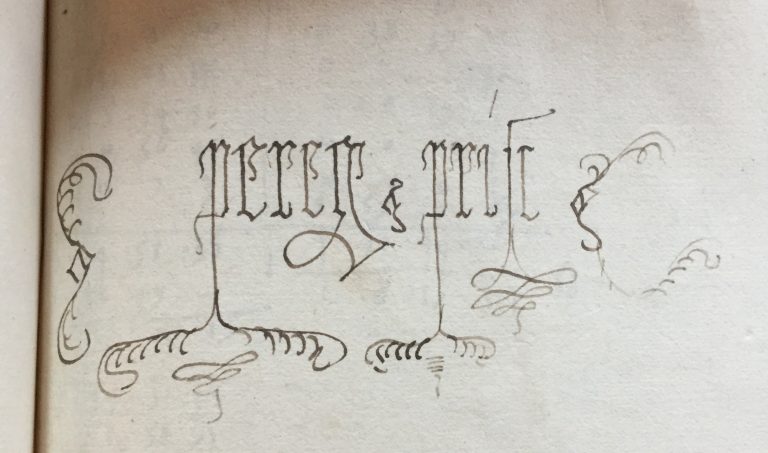Pellegrino Prisciani was undoubtedly a very multifaceted personality of the Este court, so much so that it is not possible to frame his personality and knowledge in a single definition.
He was first and foremost an outstanding humanist, in the broadest sense of the term, combining literary and scientific interests typical of the encyclopaedias of Renaissance culture: poet, writer, scholar and archivist, astronomer, politician, jurist, diplomat and above all trusted man to no less than three dukes, Borso, Ercole and Alfonso.
The Life
Pellegrino Prisciani was probably born around 1435: while the date of his birth is not certain, it is certain that his father, Prisciano Prisciani, was already connected to the Este court in the role of general factor and ducal secretary under Borso d’Este. Pellegrino initially practised as a notary professor at the Studio di Ferrara between 1455-56, then followed in his father’s footsteps, dedicating his life to the service of the Dukes.
In 1461, he was appointed to the ducal archives and library: in the years that followed, this position became more and more prominent until 1488 when he was appointed Conservator jurium ducalis Camerae et Communis Ferrariae, i.e. in charge of the ducal archives and library. Between 1469-70, he was also in charge of supervising the work of the painters employed by Borso in the frescoes in the Salone dei Mesi in Schifanoia. In the years preceding this new important post, Prisciani had begun his first magical astrological studies, and in the latter part of his life he was appointed to the chair of Astrology: he left his post as conservator iurium after 1505 and obtained the position of reader of astrology at the Studio Ferrarese, which he held until his death in January 1518.
After his father’s death, he was entrusted with new political-administrative tasks: between 1475 and 1487 he was mayor of several cities (Massa Lombarda, Badia Polesine, Lendinara, Reggio Emilia and Mantua). From 1481 he was engaged in a long series of ambassadorships to Venice, where he was sent as a major expert on the juridical-documentary sources relating to the Este family’s territorial rights against the Venetians. In 1501 he was sent to Rome as a diplomat, probably to follow the negotiations of the marriage between Alfonso and Lucrezia Borgia, for which he himself delivered the wedding oration, as he had done in 1473 for Ercole and Eleonora of Aragona.

The activity of archivist and the works
At court, he devoted himself energetically and steadily to his work as an archivist: as conservator iurium, he understood the importance for the Court of having an organised and effective archive, so that documents could be used on diplomatic missions. Hence his strictness in the preservation of documents: it is these, in fact, that prove a right and without which no trace would remain of the agreement reached or the privilege acquired.
The arrangement of these documents, according to criteria he himself adopted, is the basis for the drafting of his Collectanea and Historiae Ferrariae. The former consist of a miscellany, collected in three volumes, in which Prisciani combined documentary material of various kinds. The Historiae Ferrariae, on the other hand, is a stand-alone work, probably developed into ten books, of which only six remain, five of which are preserved in the State Archives of Modena.
His other great work is undoubtedly the treatise Spectacula, probably written around 1501: a composition dedicated to the study of buildings and venues for performances, accompanied by information, reflections and drawings to show the most effective solutions to meet Hercules I’s desire to set up a court theatre.
In 1508 he then wrote Ortho Pasca: a treatise on astronomy in Latin, first dedicated to Julius II, later corrected to Leo X. The work focuses on the reform of the Julian calendar, also with a view to the correct identification and celebration of Easter. A treatise dedicated to a Pontiff, perennially in conflict with the Estense Duchy, shows a new perspective on his intentions, thus divorced from his role in the service of the Este family.
Pellegrino Prisciani married twice and had seven children. He died in January 1518 in Ferrara.

The celebrations for the 500th anniversary of Prisciani’s death
On the final day During the celebrations for the 500th anniversary of Pellegrino Prisciani’s death, Prof. Loredana Chines (Professor of Medieval and Humanistic Literature and Philology at the Department of Classical Philology and Italianistics University of Bologna) and Prof. Paola Vecchi (Professor of Literature and Philology at the Department of Classical Philology and Italianistics University of Bologna) were interviewed.
Prisciani in the words of Professors Loredana Chines and Paola Vecchi: https://www.youtube.com/watch?v=AgFV07RB0U0
In the video, the lecturers recount the multifaceted figure of Prisciani from different points of view.
Moreover, the research carried out by ARCE (Archivio Ricerche Carteggi Estensi, born from the agreement between the State Archives of Modena and the University of Bologna) led to the realisation of a documentary exhibition, ‘Tra la corte e il mondo.Il metodo enciclopedico di Pellegrino Prisciani, umanista e officiale estense”, at the State Archives of Modena and three conferences involving Ferrara, Modena and Bologna (for information www.asmo.beniculturali.it).







